GemTek Technology ADV981119G ADSL2+ Residential Gateway User Manual Cisco 4020210A
Gemtek Technology Co., Ltd. ADSL2+ Residential Gateway Cisco 4020210A
Contents
- 1. Manual Part 1
- 2. Manual Part 2
- 3. Manual Part 3
- 4. Manual Part 4
Manual Part 4
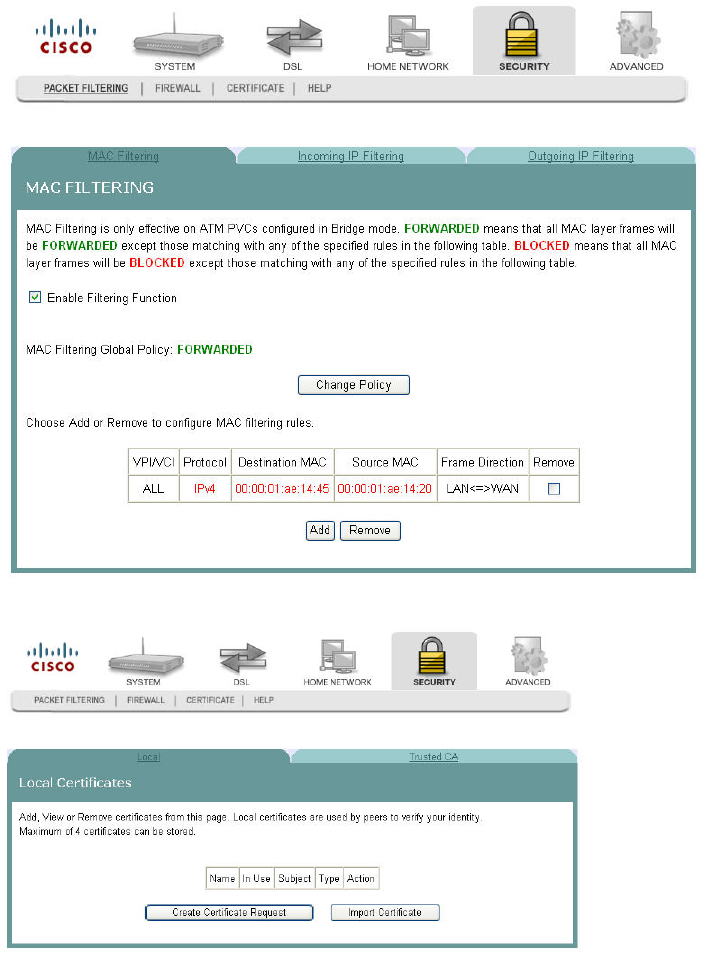
Trusted CA Certificates
4020210 Rev
A
179
1 Click Security on the main screen. The MAC Filtering screen opens by default.
2 Click Certificate. The Local Certificates screen opens.
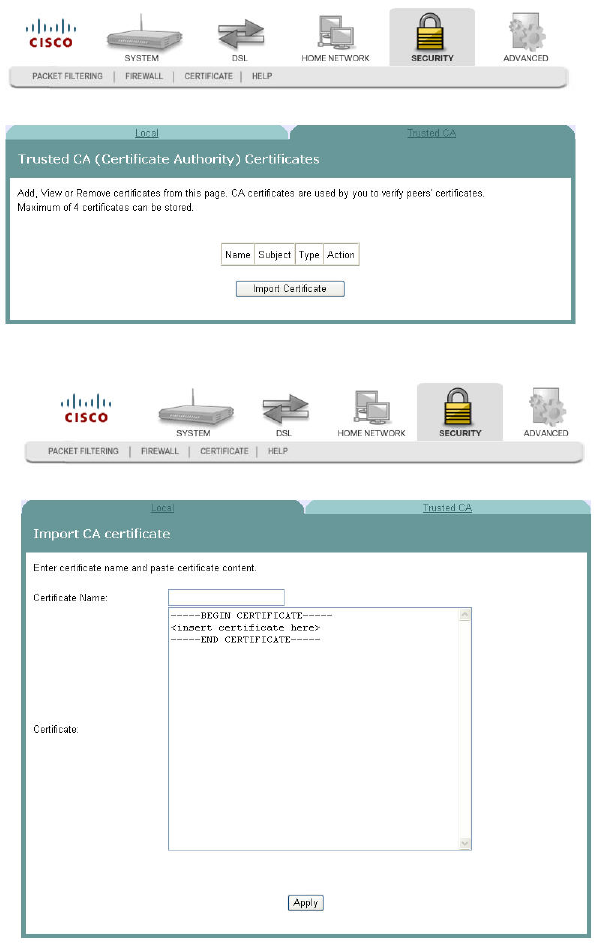
Cha
p
te
r
6 Securit
y
Confi
g
uration
180 4020210
Rev
A
3 Click the Trusted CA tab. The Trusted CA (Certificate Authority) Certificates
screen opens.
4 Click Import Certificate. The Import CA Certificate screen opens.
5 In the Certificate Name field, enter the name of the certificate.
6 In the Certificate area, copy and paste the contents of the certificate file provided
by the service provider.
7 Click Apply to save the CA certificate on the residential gateway.

4020210 Rev
A
181
The Advanced tab lets you to check the quality of service and IP traffic
over your network and change the configuration.
Use this chapter to check the status of the more advanced features of
your residential gateway, such as port mapping and DNS server
configuration, and to change the configuration.
7 Chapter 7
Advanced Configuration
In This Chapter
Upstream Quality of Service ............................................................. 182
Remote Management ......................................................................... 186
Port Mapping ...................................................................................... 188
Virtual Servers Setup.......................................................................... 191
Port Triggering Setup......................................................................... 195
DMZ Host Setup................................................................................. 199
DNS Server Configuration ................................................................ 200
DNS Entries ......................................................................................... 201
Dynamic DNS...................................................................................... 202
Nslookup.............................................................................................. 205
Default Gateway Routing.................................................................. 206
Static Route .......................................................................................... 208
Ping....................................................................................................... 209
Internet Group Management Protocol............................................. 211
IPSec Settings....................................................................................... 213
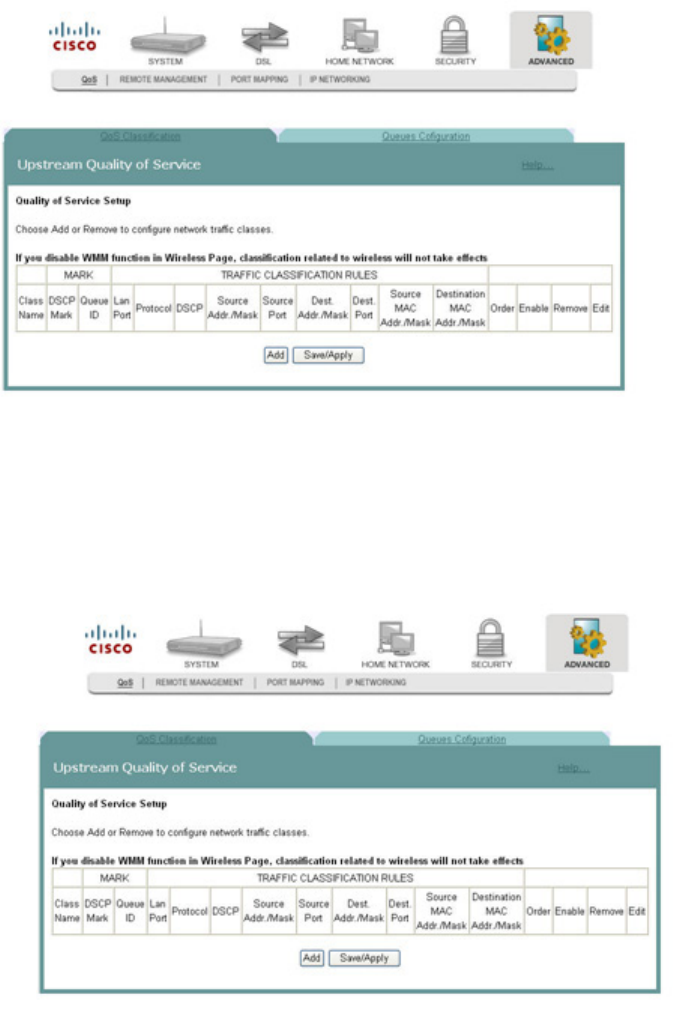
Cha
p
te
r
7 Advanced Confi
g
uration
182 4020210
Rev
A
Upstream Quality of Service
The Upstream Quality of Service screen allows you to configure the Quality of
Service (QoS) settings for the residential gateway.
Path: Advanced > QoS > Upstream Quality of Service
Adding Upstream Quality of Service Settings
To add upstream Quality of Service settings, complete the following steps.
1 Click Advanced on the main screen. The Upstream Quality of Service screen
opens.
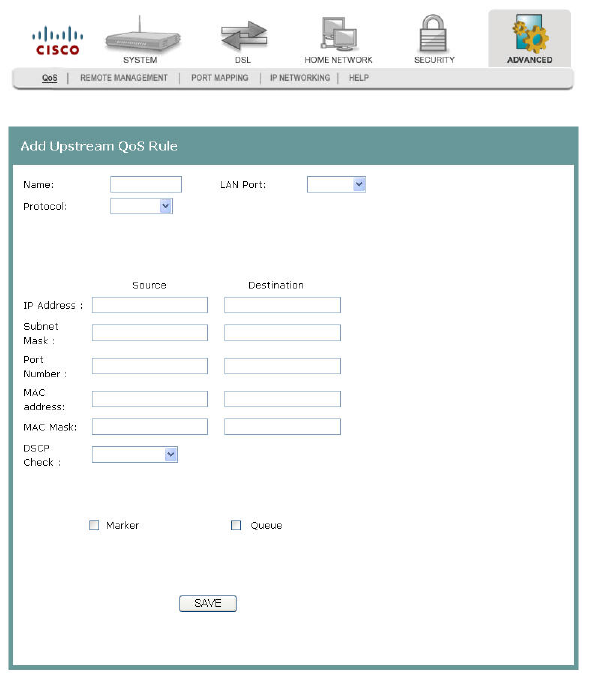
Upstream Quality of Service
4020210 Rev
A
183
2 Click Add. The Add Upstream QoS Rule screen opens.
3 In the Name field, enter the name of the QoS rule.
4 In the LAN Port field, select the LAN port for which you want to apply the rule.
5 In the Protocol field, select the protocol that you want to use from the following
options:
TCP/UDP
TCP
UDP
ICMP
6 In the IP Address field, enter the source and destination addresses.
7 In the Subnet Mask field, enter the source and destination subnet masks.
8 In the Port Number field, enter the source and destination ports.
9 In the MAC address field, enter the MAC address for the source from which the
packets are being sent and the MAC address for the destination. The MAC
address should be in the form of 6 pairs of hex digits. For example,
aa:ee:ff:11:03:24.
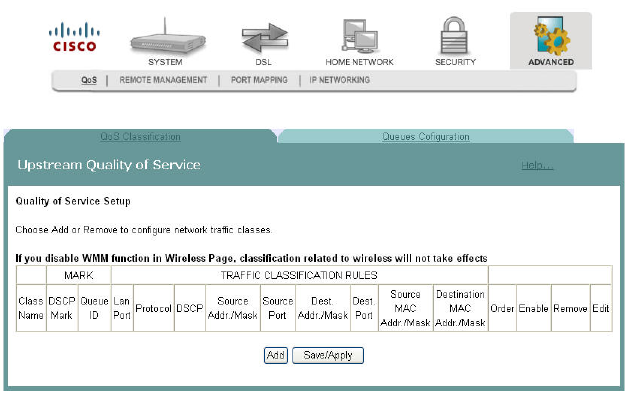
Cha
p
te
r
7 Advanced Confi
g
uration
184 4020210
Rev
A
10 In the MAC Mask field, enter the mask for the source MAC address from which
the packets are being sent and the MAC Mask for the destination MAC address.
A MAC mask of ff:ff:ff:00:00:00 matches all devices made by the same
manufacturer (identified by the first three pairs of the MAC address). A MAC
mask of ff:ff:ff:ff:ff:ff matches a single device.
11 In the DSCP Check field, select the matching DSCP value from the list of Diffserv
code point.
12 Select the Marker field and choose from the list of Diffserv code point (DSCP)
values to mark the specified data flow.
13 Select the Queue field and choose from the list of queues.
14 Click Save.
Queues Configuration
Use Queues Configuration to configure QoS queues for each WAN connection type.
By configuring the queues, you determine how the packets will be processed
according to the assigned priorities. A queue with a higher priority has lower queue
precedence.
Path: Advanced > QoS > Queues Configuration
To set up your queues, complete the following steps.
1 Click Advanced on the main screen. The Upstream Quality of Service screen
opens.
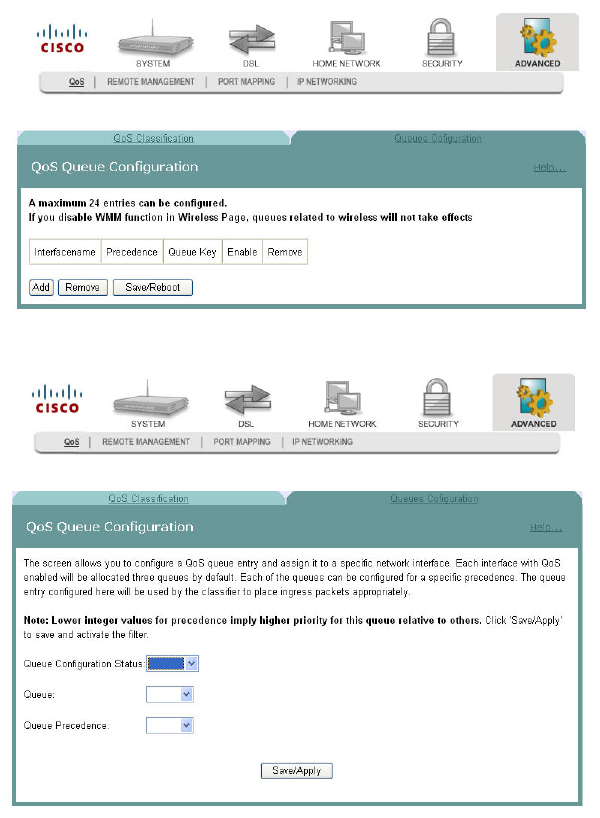
Upstream Quality of Service
4020210 Rev
A
185
2 Click Queues Configuration. The Queues Configuration screen opens.
3 Click Add to add a queue.
4 For the Queue Configuration Status, select Enable or Disable to enable or
disable your queue configuration.
5 Select from the Queue drop-down list for the associated WAN interface or
connection type for Queue.
6 For the Queue Precedence field, select the Precedence as the relative priority for
the queue. A smaller number indicates a higher priority.
7 Click Save/Apply to save the changes.
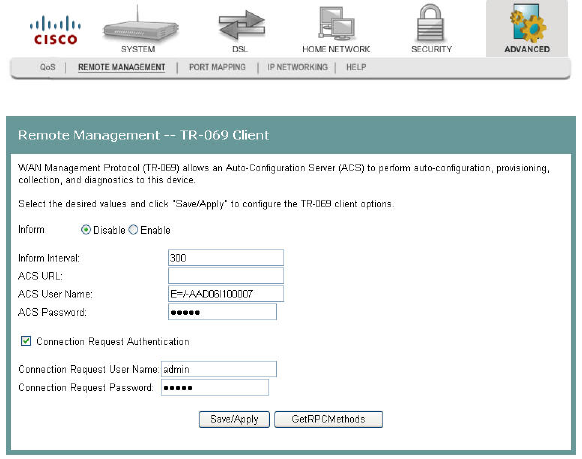
Cha
p
te
r
7 Advanced Confi
g
uration
186 4020210
Rev
A
Remote Management
The Remote Management -- TR-069 Client screen allows an auto-configuration
server (ACS) to perform auto-configuration, provisioning, collection of statistics, and
diagnostics for this residential gateway.
Path: Advanced > Remote Management
Configuring the TR-069 Client Options
To configure the TR-069 client options, complete the following steps.
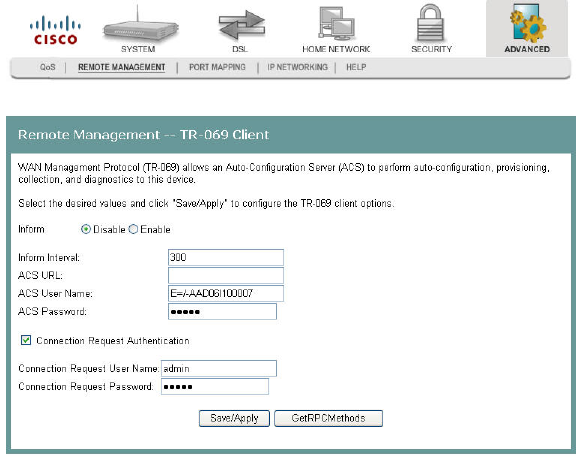
Remote Management
4020210 Rev
A
187
1 Click Advanced on the main screen. The Remote Management -- TR-069 Client
screen opens.
2 In the Inform field, choose one of the following options:
Click Enable to enable the periodic "inform" messages from the residential
gateway.
Click Disable to disable the inform messages to the residential gateway.
3 In the Inform Interval field, enter the frequency that the inform messages are sent
from the residential gateway to the auto-configuration server.
4 In the ACS URL field, enter the URL for the auto-configuration server.
5 In the ACS User Name field, enter the user name for auto-configuration server.
6 In the ACS Password field, enter the password for the auto-configuration server.
7 Check the Connection Request Authentication field.
8 In the Connection Request User Name field, enter the name of the connection
request.
9 In the Connection Request Password field, enter the password for the connection
request.
10 Click GetRPCMethods to obtain the list of remote procedural calls (RPC)
supported by the auto-configuration server.
11 Click Save/Apply to save the configuration changes.
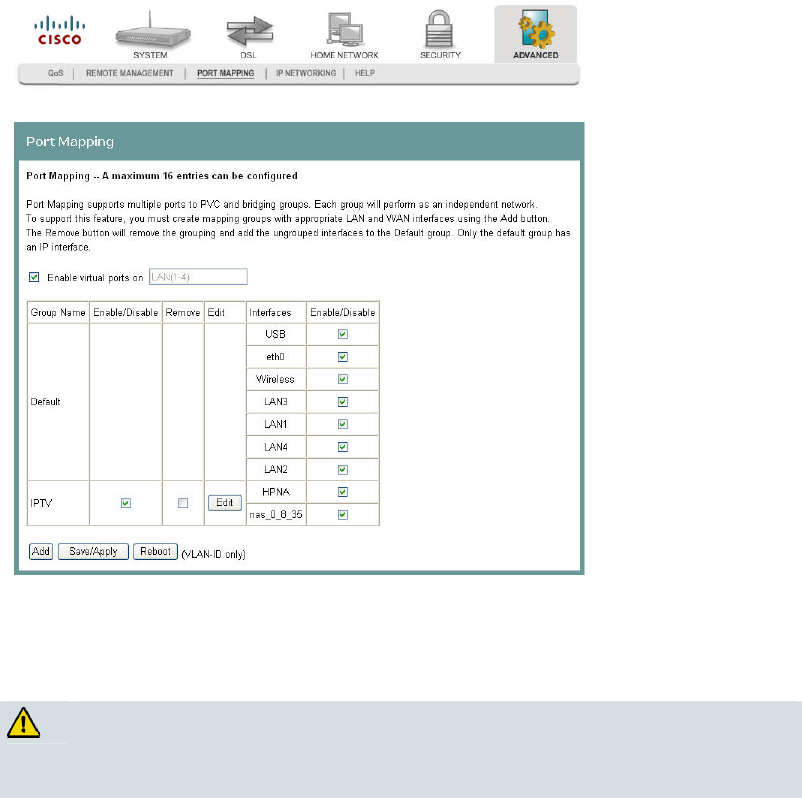
Cha
p
te
r
7 Advanced Confi
g
uration
188 4020210
Rev
A
Port Mapping
The Port Mapping screen allows you to specify which traffic will be transmitted over
the WAN interface. Traffic is classified by ingress port, such as Ethernet port, or by
DHCP option settings. Port Mapping supports multiple ports to PVC and bridging
groups. Each group will perform as an independent network. To support this
feature, you must create mapping groups with appropriate LAN and WAN
interfaces.
Path: Advanced > Port Mapping
Adding Port Mapping
To add port mapping, complete the following steps.
CAUTION:
This procedure is for administrators only. Incorrectly using this function can
adversely affect your system operation.
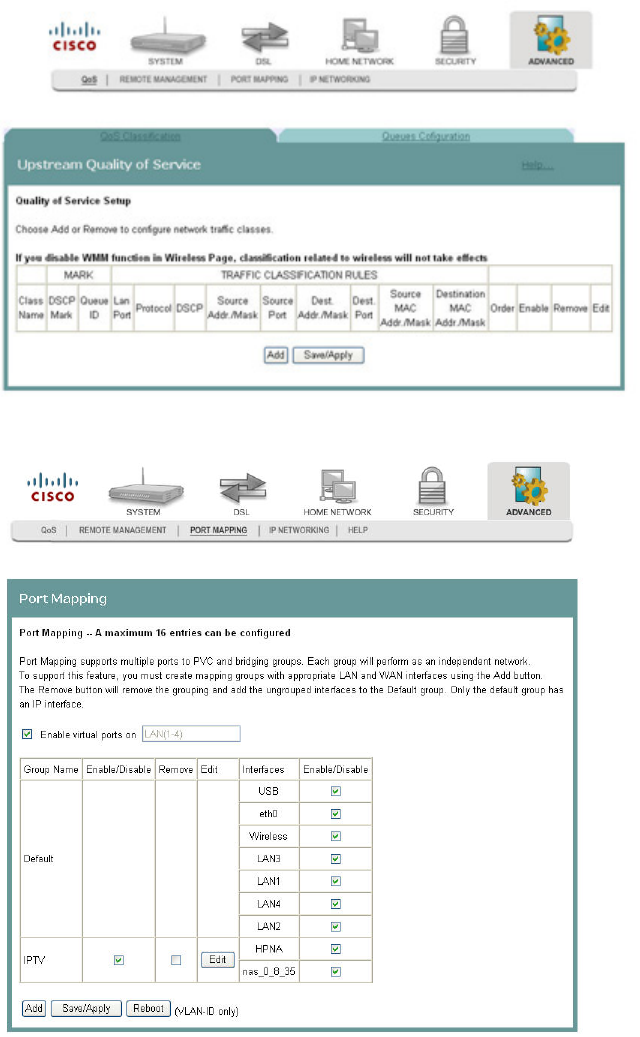
Port Mapping
4020210 Rev
A
189
1 Click Advanced on the main screen. The Upstream Quality of Service screen
opens.
2 Click the Port Mapping tab. The Port Mapping screen opens.
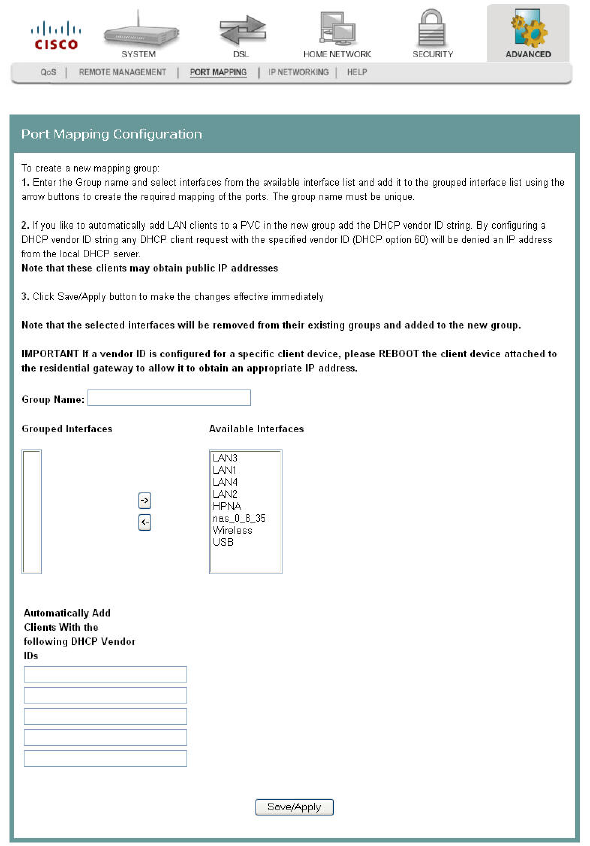
Cha
p
te
r
7 Advanced Confi
g
uration
190 4020210
Rev
A
3 Click Add. The Port Mapping Configuration screen opens.
4 In the Group Name field, enter the name of the group. The group name must be
unique. For example, enter IPTV.
5 For the Grouped Interfaces field, select interfaces from the Available Interfaces
list and add them to the grouped interface list using the arrow buttons to create
the required mapping of the ports.
6 In the Automatically Add Clients With the following DHCP Vendor IDs fields,
add the DHCP option 60 [vendor ID option] string for the devices (typically IP
set-tops) attached to the residential gateway.
7 Click Save/Apply.
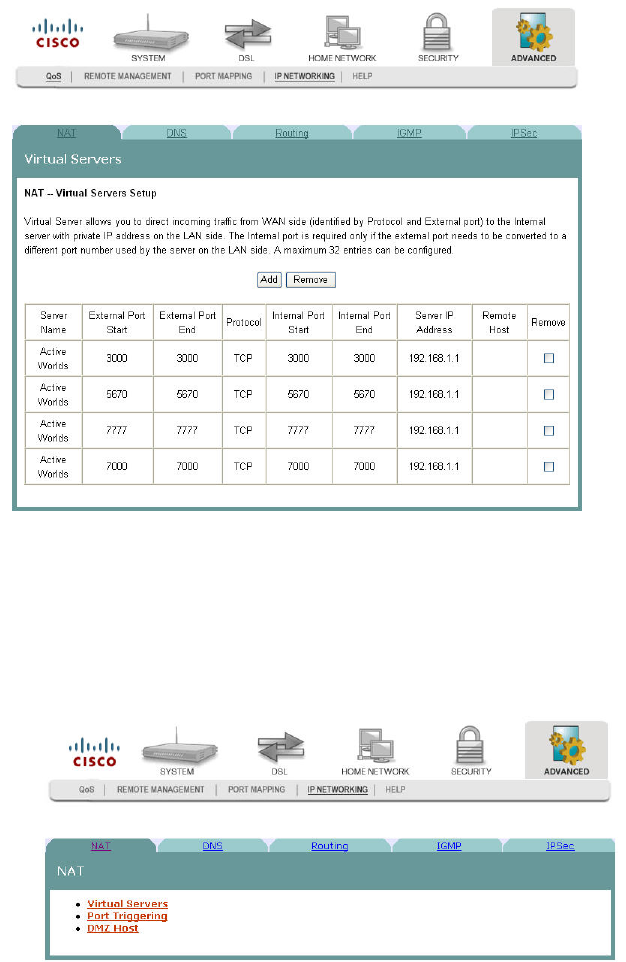
Virtual Servers Setup
4020210 Rev
A
191
Virtual Servers Setup
The NAT -- Virtual Servers Setup screen allows you to configure servers to which
you want to forward IP packets that belong to a specific service.
Path: Advanced > IP Networking > NAT > Virtual Servers
Adding a Virtual Server
To add and configure a virtual server, complete the following steps.
1 Click Advanced on the main screen.
2 Click IP Networking. The NAT screen opens.
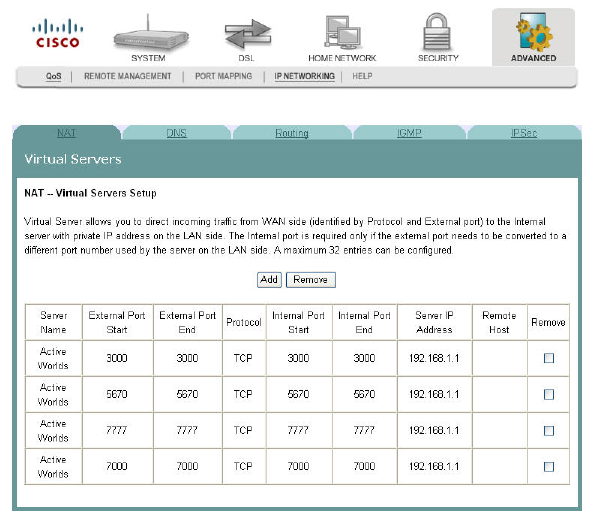
Cha
p
te
r
7 Advanced Confi
g
uration
192 4020210
Rev
A
3 Click Virtual Servers. The Virtual Servers screen opens.
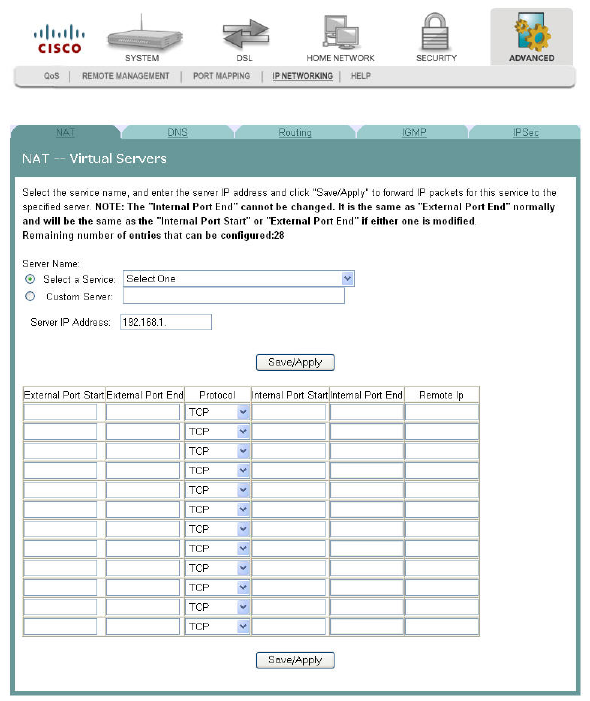
Virtual Servers Setup
4020210 Rev
A
193
4 From the Virtual Servers Setup screen, click Add. The NAT -- Virtual Servers
screen opens.
5 Under Server Name, choose one of the following:
Click Select a Service, and choose a service from the drop-down list.
OR
Click Custom Server, and enter a server name and the Server IP Address.
6 In the Server IP Address field, enter the IP address for the server.
7 In the External Port Start/End fields, assign the external (Internet) port range of
numbers that are associated with the service. These are the ports which will be
used for receiving the service request from the WAN. If you have chosen to
Select a Service from the above selection, the ports will be entered automatically
for you.
8 Under Protocol, select TCP, UDP, or TCP/UDP.
9 In the Internet Port Start/End fields, assign the internal (LAN) port range of
numbers that are associated with the service. These are the ports which the
actual LAN server defines. If you have chosen to Select a Service from the above
selection, the ports will be entered automatically for you.
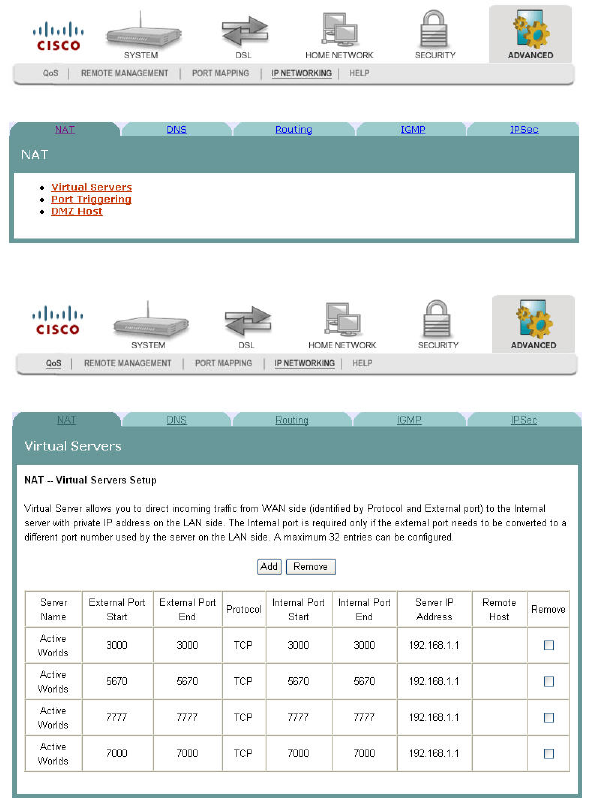
Cha
p
te
r
7 Advanced Confi
g
uration
194 4020210
Rev
A
10 In the Remote IP field, enter the service request (client) sender's IP address.
Leave it blank to accept all incoming service requests regardless of the senders'
IP address.
11 Click Save/Apply to add the virtual server.
Removing a Virtual Server
To remove a virtual server, complete the following steps.
1 Click Advanced on the main screen.
2 Click IP Networking. The NAT screen opens.
3 Click Virtual Servers. The Virtual Servers screen opens.
4 From the NAT -- Virtual Servers Setup screen, select Remove in the Remove
column next to the server you wish to remove.
5 Click Remove to remove the NAT Virtual Server.
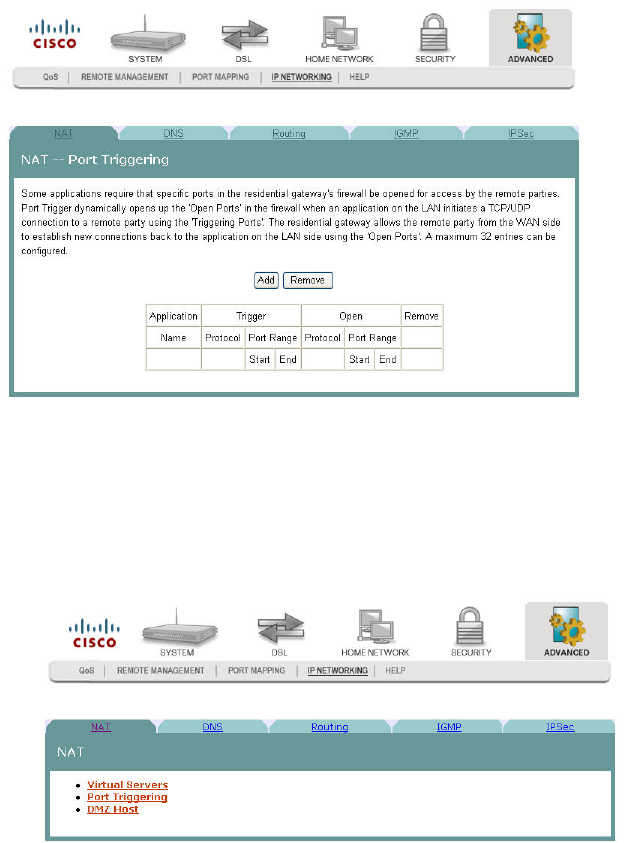
Port Triggering Setup
4020210 Rev
A
195
Port Triggering Setup
Some applications require that specific ports in the router's firewall be opened for
access by the remote parties. The Port Triggering feature dynamically opens up the
"Open Ports" in the firewall when an application on the LAN initiates a TCP/UDP
connection to a remote party using the Triggering Ports feature. The router allows
the remote party from the WAN side to establish new connections with the
application on the LAN side using the open ports. A maximum of 32 entries can be
configured.
The NAT -- Port Triggering screen allows you to configure servers to which you
want to forward IP packets that belong to a specific service.
Path: Advanced > IP Networking > NAT > Port Triggering > NAT -- Port
Triggering
Opening a Port on the Firewall
To open a port on the firewall, complete the following steps.
1 Click Advanced on the main screen.
2 Click IP Networking. The NAT screen opens.
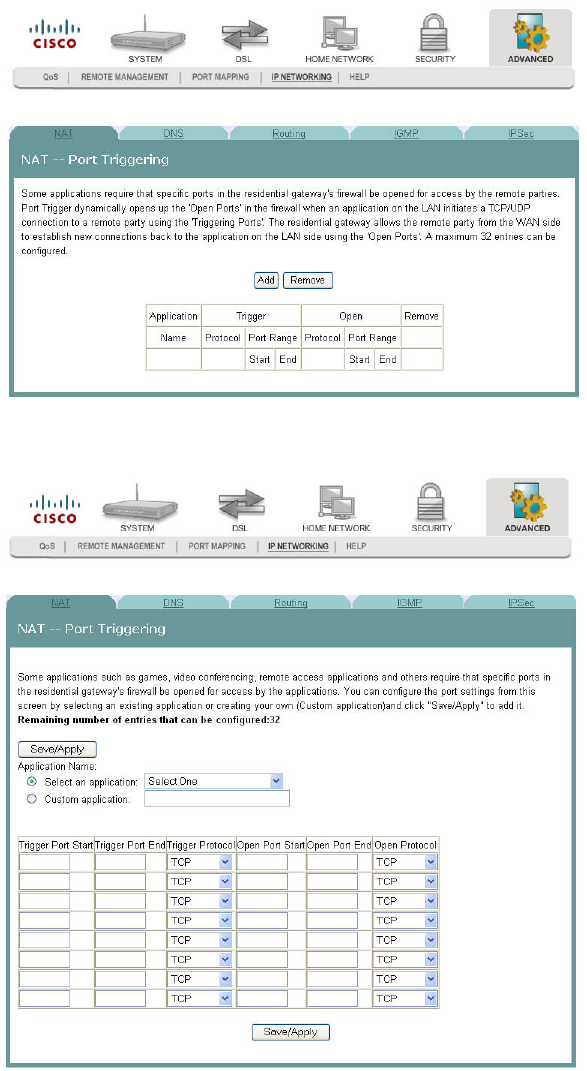
Cha
p
te
r
7 Advanced Confi
g
uration
196 4020210
Rev
A
3 Click Port Triggering. The NAT -- Port Triggering screen opens.
4 From the NAT -- Port Triggering screen, click Add. The NAT Port Triggering
screen opens with a list of available protocols.
5 Under Application Name, choose one of the following:
Click Select an Application and choose an application from the drop-down
list.
OR
Click Custom Application, and enter a name for the application.
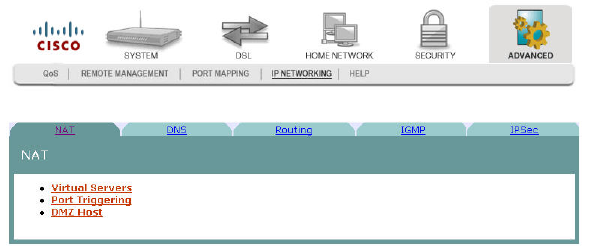
Port Triggering Setup
4020210 Rev
A
197
6 Complete the fields on the screen as follows:
Under Trigger Port Start, enter the triggering port (start) that will cause the
residential gateway to open up the incoming port for the particular LAN
computer.
Under Trigger Port End, enter the triggering port (end) that will cause the
residential gateway to open up the incoming port for the particular LAN
computer.
Under Trigger Protocol, select TCP/UDP, TCP or UDP.
Under Open Port Start, enter the starting port number of the service you
want to open on the firewall.
Under Open Port End, enter the ending port number of the service you want
to open on the firewall.
Under Open Protocol, select TCP/UDP, TCP or UDP.
7 Click Save/Apply to open the ports on the firewall.
Closing a Port on the Firewall
To close a port on the firewall, complete the following steps.
1 Click Advanced on the main screen.
2 Click IP Networking. The NAT screen opens.
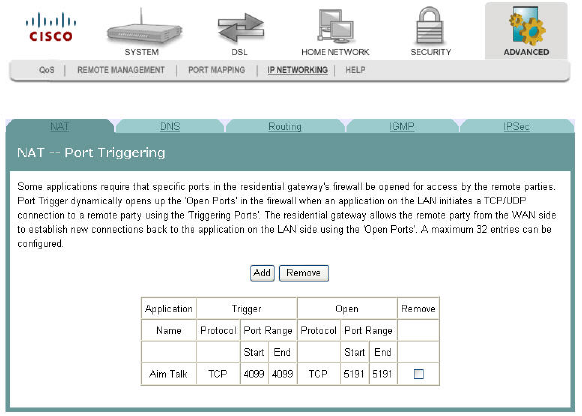
Cha
p
te
r
7 Advanced Confi
g
uration
198 4020210
Rev
A
3 Click Port Triggering. The NAT -- Port Triggering screen opens.
4 From the NAT -- Port Triggering screen, click Remove in the Remove column
next to the port you wish to close.
5 Click Remove. The port you selected is closed.
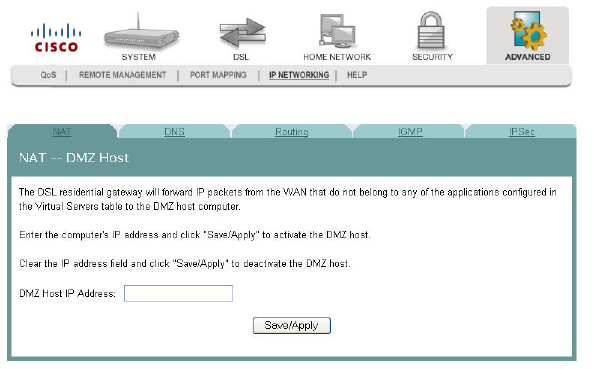
DMZ Host Setup
4020210 Rev
A
199
DMZ Host Setup
The NAT -- DMZ Host screen allows the IP packets from the WAN that do not
belong to any of the applications configured in the Virtual Servers table to be
forwarded to the DMZ (demilitarized zone) host computer.
Path: Advanced > IP Networking > NAT > DMZ Host > NAT -- DMZ Host
Activate the DMZ Host
In the DMZ Host IP Address field, enter the computer's IP address and click
Save/Apply to activate the DMZ host.
Deactivate the DMZ Host
Clear the DMZ Host IP Address field and click Save/Apply to deactivate the DMZ
host.
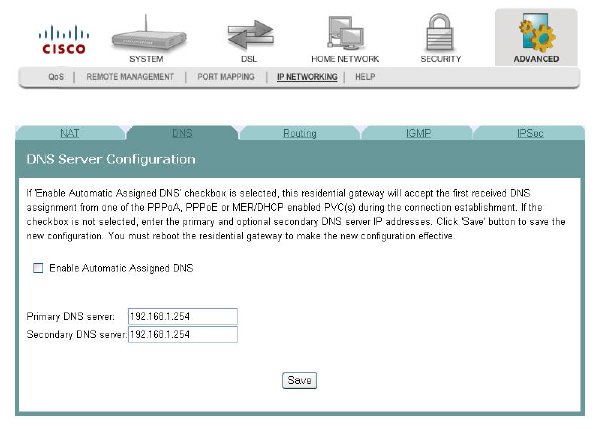
Cha
p
te
r
7 Advanced Confi
g
uration
200 4020210
Rev
A
DNS Server Configuration
The DNS Server Configuration screen allows you to configure the Domain Name
Server (DNS).
If the Enable Automatic Assigned DNS check box is checked, the residential gateway
will accept the first received DNS assignment from one of the PPPoA, PPPoE or
MER/DHCP enabled PVC(s) during the connection establishment. If the check box
is not checked, enter the primary and optional secondary IP address or domain
name address of the DNS server to establish connection. Click Save to save the new
configuration. You must reboot the residential gateway to make the new
configuration effective.
Path: Advanced > IP Networking > DNS > DNS Server
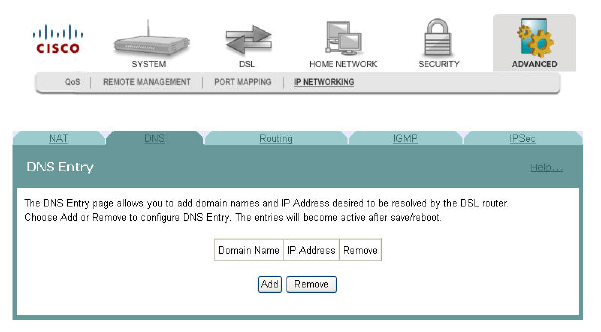
DNS Entries
4020210 Rev
A
201
DNS Entries
The DNS Entries page allows you to add domain names and the IP addresses to be
resolved by the Gateway. You could add a DNS entry by entering the Domain name
and the corresponding IP address in the fields. Click Save/Apply to save your
settings.
Path: Advanced > IP Networking > DNS > DNS Entries
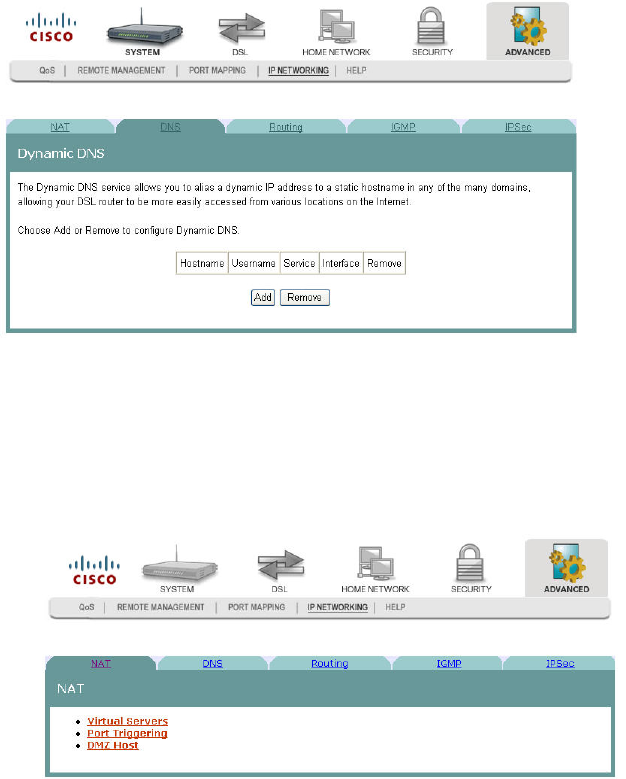
Cha
p
te
r
7 Advanced Confi
g
uration
202 4020210
Rev
A
Dynamic DNS
The Dynamic DNS screen allows you to alias a dynamic IP address to a static
hostname in any of the many domains. The alias allows your DSL router to be more
easily accessed from various locations on the Internet.
Path: Advanced > IP Networking > DNS > Dynamic DNS
Adding an Alias for A Dynamic IP Address to a Static Host Name
To alias a dynamic IP address to a static host name, complete the following steps.
1 Click Advanced on the main screen.
2 Click IP Networking. The NAT screen opens.
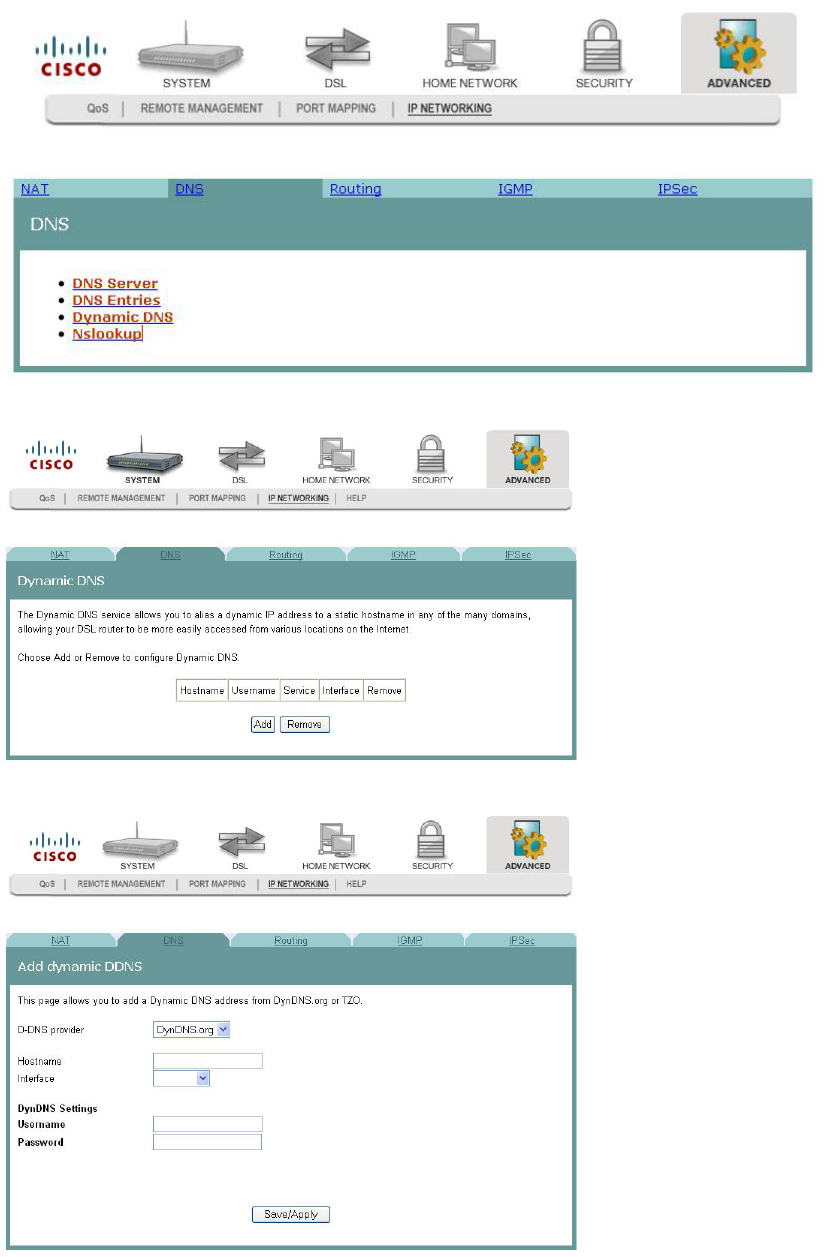
Dynamic DNS
4020210 Rev
A
203
3 Click DNS. The DNS screen opens.
4 Click Dynamic DNS. The Dynamic DNS screen opens.
5 Click Add on the Dynamic DNS screen. The Add dynamic DDNS screen opens.
Cha
p
te
r
7 Advanced Confi
g
uration
204 4020210
Rev
A
6 In the D-DNS provider field, select the provider from the drop-down list.
7 In the Hostname field, enter the name of the host.
8 In the Interface field, select the interface from the drop-down list.
9 Under DynNDS Settings, enter your user name and password.
10 Click Save/Apply.
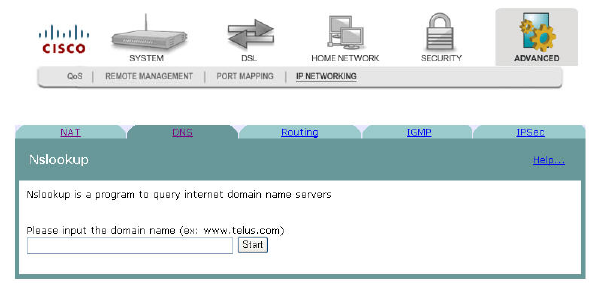
Nslookup
4020210 Rev
A
205
Nslookup
The Nslookup tool is a utility to look up information in the DNS (Domain Name
System). Basically, DNS maps domain names to IP addresses. Type in the domain
name in the field, and press Start to look up the IP address.
Path: Advanced > IP Networking > DNS > Nslookup
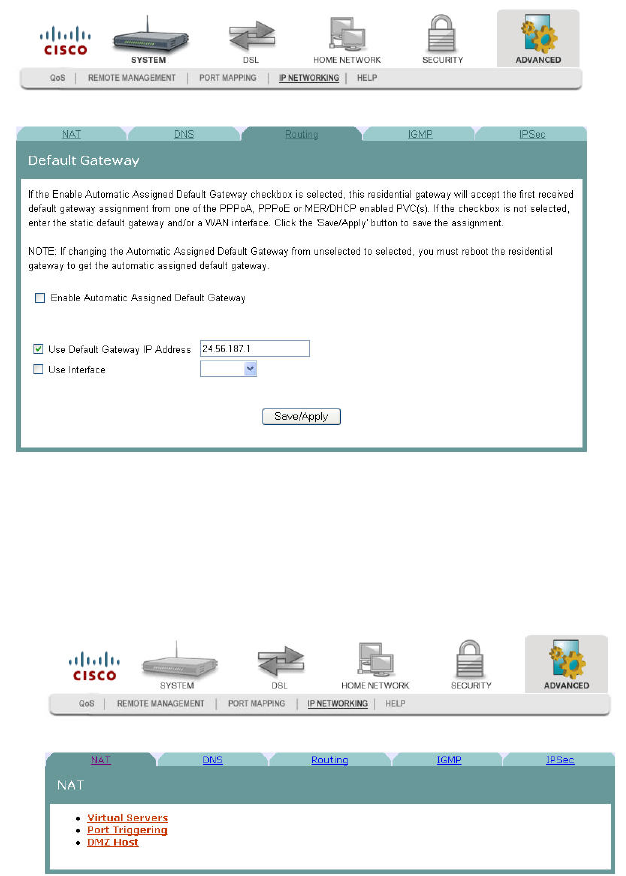
Cha
p
te
r
7 Advanced Confi
g
uration
206 4020210
Rev
A
Default Gateway Routing
The Default Gateway screen allows you to make gateway assignments for devices
that are connected to the residential gateway.
Note: If you change the Enable Automatic Assigned Default Gateway check box
from unselected to selected, you must reboot the router to get the automatic
assigned default gateway.
Path: Advanced > IP Networking > Routing > Default Gateway
Assigning Default Gateways
To assign a default gateway, complete the following steps.
1 Click Advanced on the main screen.
2 Click IP Networking. The NAT screen opens.
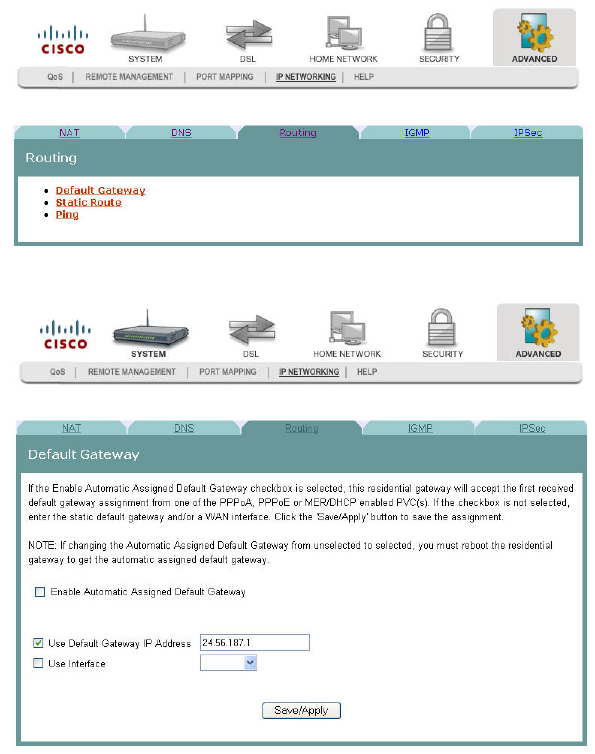
Default Gateway Routing
4020210 Rev
A
207
3 Click Routing. The Routing screen opens.
4 Click Default Gateway. The Default Gateway screen opens.
5 Do you want to enable the automatic assigned default gateway?
If yes, be sure the Enable Automatic Assigned Default Gateway check box is
checked. If this check box is checked, the residential gateway will accept the
first received default gateway assignment from one of the PPPoA, PPPoE or
MER/DHCP enabled PVC(s).
If no, be sure the Enable Automatic Assigned Default Gateway check box is
unhecked. If the check box is not checked, enter the default gateway IP
address AND/OR a WAN interface from the drop-down list for the Use
Interface field.
6 Click Save/Apply to save your selection.
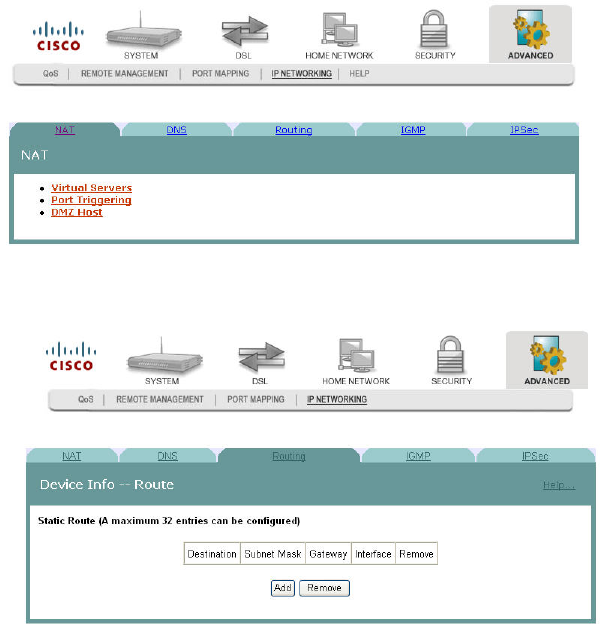
Cha
p
te
r
7 Advanced Confi
g
uration
208 4020210
Rev
A
Static Route
The Residential Gateway lets you set up static routes when routing packets from a
specific network to another.
Path: Advanced > IP Networking > Routing > Static Route
To add a static routing entry, complete the following steps.
1 Click Advanced on the main screen.
2 Click IP Networking. The NAT screen opens.
3 Click Routing. The Routing screen opens.
4 Click Static Route. The Device Info -- Route screen opens.
5 Click Add to add a new entry.
6 Enter the Destination Network Address which should be a network ID for the
destined network.
7 Enter the Subnet Mask for the destined network.
8 Select Use Gateway IP Address and identify the Gateway's IP Address to which
the packet is forwarded.
9 Select Use Interface for the interface that is used to forward the packet from the
drop-down menu.
10 Click Save/Apply at the bottom of the screen.
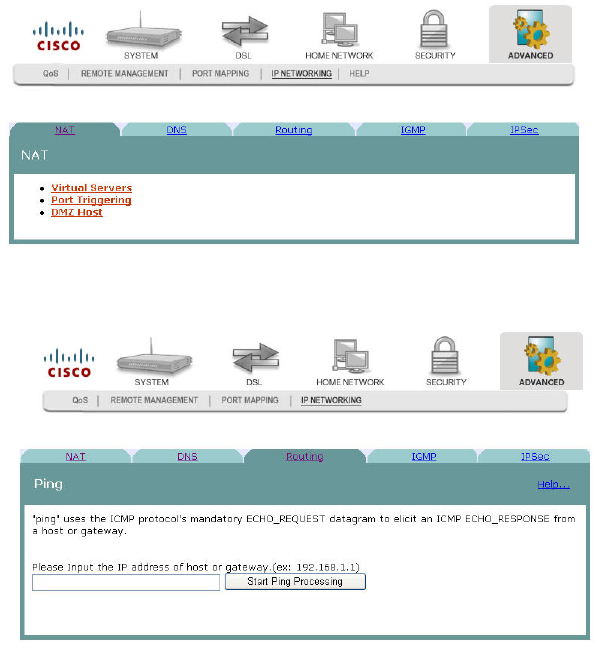
Ping
4020210 Rev
A
209
Ping
The ping utility could be used to test the connectivity with other network devices.
Path: Advanced > IP Networking > Routing > Ping
To test the connectivity with other devices (ping them), complete the following
steps.
1 Click Advanced on the main screen.
2 Click IP Networking. The NAT screen opens.
3 Click Routing. The Routing screen opens.
4 Click Ping. The Ping window opens.
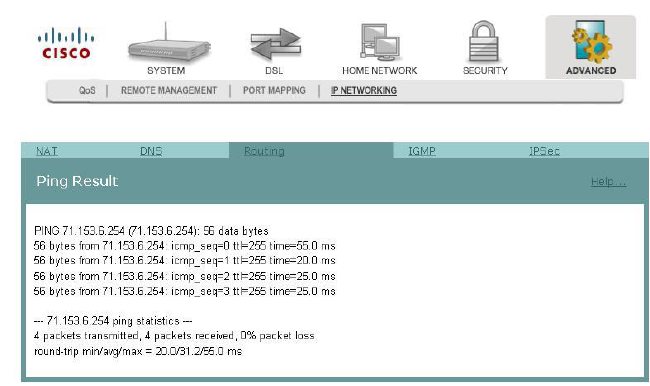
Cha
p
te
r
7 Advanced Confi
g
uration
210 4020210
Rev
A
5 Enter the IP address of a remote host and click Start Ping Processing. The Ping
result appears on the screen as shown below.
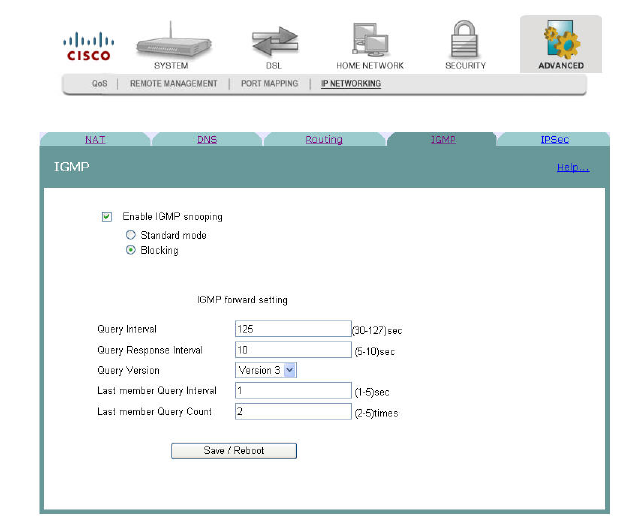
Internet Group Management Protocol
4020210 Rev
A
211
Internet Group Management Protocol
The IGMP screen allows you to configure the Internet Group Management Protocol
(IGMP) parameters. IGMP is a communications protocol that is used to manage the
membership of Internet Protocol multicast groups. Routers use IGMP to manage
multicasting. The IGMP messages are used to determine which host is part of which
multicast group.
Path: Advanced > IP Networking > IGMP
Enabling IGMP Snooping
To enable IGMP snooping, complete the following steps.
1 Check the Enable IGMP snooping check box.
2 Select Standard mode to flood unknown multicast traffic. Select Blocking to
discard unknown multicast traffic.
3 In the Query Interval field, enter the interval in seconds. The Query Interval is
the amount of time in seconds between IGMP Host Query messages sent by the
router.
4 In the Query Response Interval field, enter the interval in seconds. The Query
Response Interval is the maximum amount of time in seconds that the IGMP
router waits to receive a response to an IGMP Query message.
5 In the Query Version field, choose the version from the drop-down list.
Cha
p
te
r
7 Advanced Confi
g
uration
212 4020210
Rev
A
6 In the Last member Query Interval field, enter the interval in seconds. It is the
amount of time in seconds that the IGMP router waits to receive a response to a
Group-Specific Query message.
7 In the Last member Query Count field, enter the value in numbers. It is the
number of Group-Specific Query messages sent upon receipt of a message
indicating a leave. (The default is 2.)
8 Click Save/Reboot to save your changes and reboot the system.enter the value in
numbers. The default is 2. It is the number of Group-Specific Query messages
sent upon receipt of a message indicating a leave.
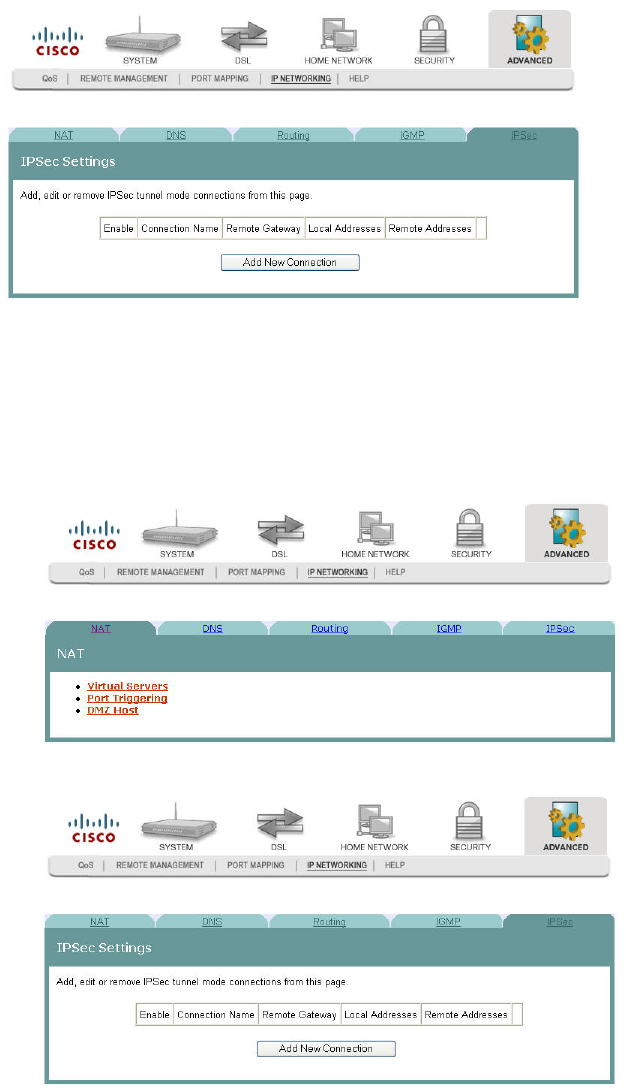
IPSec Settings
4020210 Rev
A
213
IPSec Settings
The IPSec Settings screen allows you to configure IP security settings for the
residential gateway.
Path: Advanced > IP Networking > IPSec
Adding an IPSec Connection
To add an IPSec connection, complete the following steps.
1 Click Advanced on the main screen.
2 Click IP Networking. The NAT screen opens.
3 Click IPSec. The IPSec Settings screen opens.
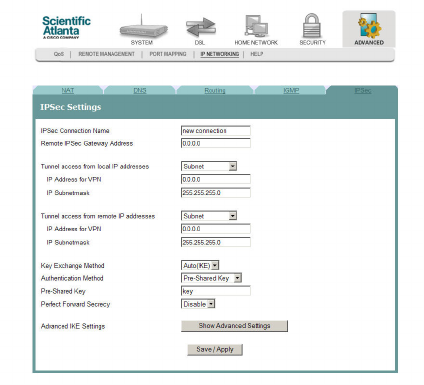
Cha
p
te
r
7 Advanced Confi
g
uration
214 4020210
Rev
A
4 Click Add New Connection. The IPSec Settings screen opens.
5 In the IPSec Connection Name field, enter the name of the connection.
6 In the Remote IPSec Gateway Address field, enter the gateway address for the
remote IPSec gateway.
7 In the Tunnel access from local IP addresses field, select Subnet or Single
Address.
8 In the IP Address for VPN, enter the IP address for the VPN connection.
9 In the IP Subnetmask field, enter the subnet mask for the VPN IP address.
10 In the Tunnel access from remote IP addresses field, select Subnet or Single
Address.
11 In the IP Address for VPN, enter the IP address for the VPN connection.
12 In the IP Subnetmask field, enter the subnet mask for the VPN IP address.
13 In the Key Exchange Method field, select Auto(IKE) or manual.
14 In the Authentication Method field, select Pre-Shared Key or Certificate (X.509).
15 Depending upon the authentication method that you selected, do one of the
following:
If you selected Pre-Shared Key, enter the name of the key in the Pre-Shared
Key field.
OR
If you selected Certificate (X.509), select a certificate from the drop-down list
of certificates in the Certificate field.
16 In the Perfect Forward Secrecy field, select one of the following options:
If you select Enable, Perfect Forward Secrecy is enabled.
OR
If you select Disable, Perfect Forward Secrecy is disabled.
17 Do you want to configure the advanced settings?
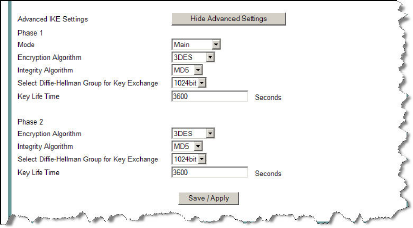
IPSec Settings
4020210 Rev
A
215
If yes, in the Advanced IKE Settings field, click Show Advanced Settings to
populate the screen with advanced settings.
If no, go to step 20.
18 Complete the advanced settings as follows:
a In the Phase 1 Mode field, select Main or Aggressive.
b In the Encryption Algorithm field, select one of the following encryption
algorithms:
– 3DES
– AES -128
– AES - 192
– AES - 256
c In the Integrity Algorithm field, select MD5 or SHA1.
d In the Select Diffie-Hellman Group for Key Exchange field, select one of the
following options:
– 768 bit
– 1024 bit
– 1536 bit
– 2048 bit
– 3072 bit
– 4096 bit
– 6144 bit
– 8192 bit
e In the Key Life Time, enter the life of the key in seconds.
19 Repeat step 15 through 18 for each phase.
20 Click Save/Apply to save your settings.

4020210 Rev
A
217
Introduction
This chapter provides contact information to obtain product support
and return products for service.
8 Chapter 8
Customer Information
In This Chapter
Customer Support .............................................................................. 218
Return Products for Repair................................................................ 220

Cha
p
te
r
8 Custome
r
Information
218 4020210
Rev
A
Customer Support
If You Have Questions
If you have questions about this product, contact the representative who handles
your account for information.
If you have technical questions, telephone your nearest technical support office at
one of the following telephone numbers.
The Americas
United States Cisco® Services
Atlanta, Georgia
Technical Support
For Digital Broadband Delivery System products
only, call:
– Toll-free: 1-800-283-2636
– Local: 770-236-2200
– Fax: 770-236-2488
For all products other than Digital Broadband
Delivery System, call:
– Toll-free: 1-800-722-2009
– Local: 678-277-1120
– Fax: 770-236-2306
Customer Service
Toll-free: 1-800-722-2009
Local: 678-277-1120
Fax: 770-236-5477
The United Kingdom and Europe
Europe European Technical
Assistance Center
(EuTAC), Belgium
Product Information
Telephone: 32-56-445-444
Technical Support
Telephone: 32-56-445-197 or 32-56-445-155
Fax: 32-56-445-061
Asia-Pacific
China Hong Kong
Technical Support
Telephone: 011-852-2588-4745
Fax: 011-852-2588-3139

Customer Support
4020210 Rev
A
219
Australia
Australia Sydney Technical Support
Telephone: 011-61-2-8446-5374
Fax: 011-61-2-8446-8015
Japan
Japan Tokyo Technical Support
Telephone: 011-81-3-5322-2067
Fax: 011-81-3-5322-1311
Additional Information
Access your company's extranet site to view or order additional technical
publications. For accessing instructions, contact the representative who handles your
account. Check your extranet site often as the information is updated frequently.
Cha
p
te
r
8 Custome
r
Information
220 4020210
Rev
A
Return Products for Repair
You must obtain a return material authorization (RMA) number before you send
products to us for repair or upgrade. To return a product for repair or upgrade,
complete the following steps.
1 Obtain the following information about the product that you want to return for
repair or upgrade:
The name and model number (if applicable) of the product and the quantity
of returns
A reason for the return, such as upgrade or failure symptom
Your company name, contact, telephone number, email address, fax number,
repair disposition authority, and any service contract details
A purchase order number
Notes:
– If you are unable to issue a purchase order at the time you request an
RMA number, a proforma invoice will be sent to you at the completion of
repair. This invoice lists all costs incurred.
– We must receive a purchase order within 15 days of receipt of proforma.
Important: In-warranty products can accrue costs through damage or misuse, or
if no problem is found. Products incurring costs will not be returned to the
customer without a valid purchase order.
2 Telephone or fax Factory Services at one of the following numbers to request an
RMA number:
From North America, call:
– Tel: 1-800-722-2009
– Fax: 770-236-5477
From Europe, Middle East,
or Africa, call:
– Tel: 32-56-445-444
– Fax: 32-56-445-051
From Latin America, call:
– Tel: 1-770-236-5662
– Fax: 1-770-236-5888
From Asia Pacific, call:
– Tel: 852-2588-4746
– Fax: 852-2588-3139
Result: The customer service representative will provide the RMA number and
the shipping instructions to you.
Note: RMA numbers are only valid for 60 days. You must contact a customer
service representative to revalidate your RMA numbers if the number is older
than 60 days. After the RMA number is revalidated, you can return the product.
Return Products for Repair
4020210 Rev
A
221
3 Pack the product in its original container and protective packing material.
Important:
If the original container and packing material are no longer available, pack
the product in a sturdy, corrugated box and cushion it with packing material
that is appropriate for the method of shipping.
You are responsible for delivering the returned goods to us safely and
undamaged. Improperly packaged shipments, which may have caused
additional damage, may be refused and returned to you at your expense.
Do not return any power cords or accessories.
4 Write the following information on the outside of the container:
Your name
Your complete address
Your Telephone number
RMA number
Problem description (for product failures)
Important: Absence of the RMA number may delay processing your product for
repair. Include the RMA number in all correspondence.
5 Ship the product to the address you receive from the customer service
representative.
Important: We do not accept freight collect. Be sure to prepay all shipments.

Cisco Systems, Inc.
5030 Sugarloaf Parkway, Box 465447
Lawrenceville, GA 30042
678.277.1000
www.cisco.com
This document includes various trademarks of Cisco Systems, Inc. Please see the Notices
section of this document for a list of the Cisco Systems, Inc. trademarks used in this
document.
Product and service availability are subject to change without notice.
© 2009 Cisco Systems, Inc. All rights reserved.
November 2009 Printed in United States of America
Part Number 4020210 Rev A